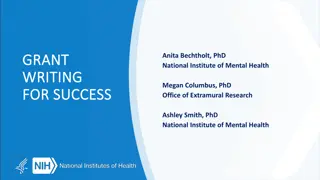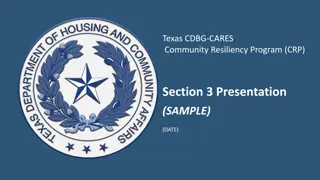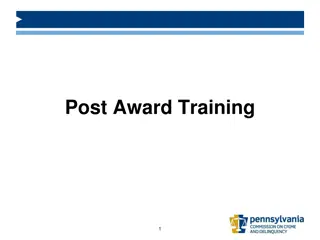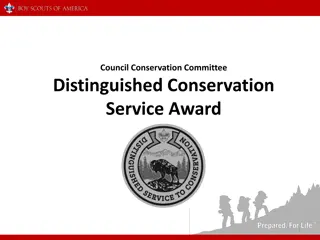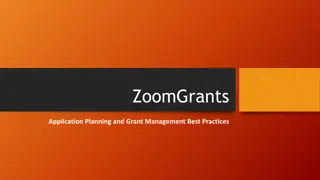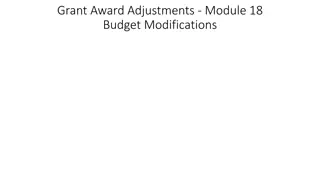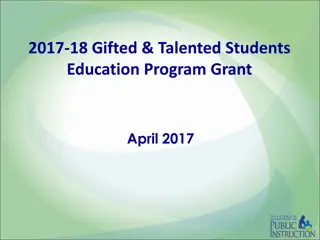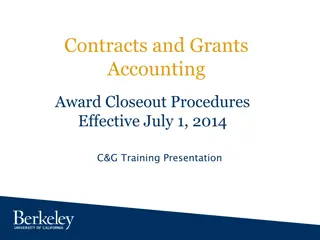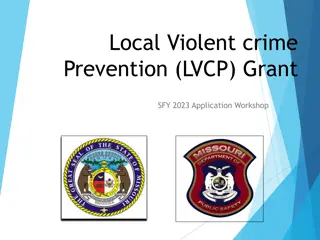The Post-Award Process in Grant Management
Exploring what happens after a grant award is made, this resource covers topics such as understanding the Notice of Award, accessing funds, annual reporting, unobligated balances, prior approval requirements, and closeout reporting. The importance of reviewing the Notice of Award document thoroughly, grantees' acceptance process, and guidelines for accessing funds are discussed in detail.
Download Presentation

Please find below an Image/Link to download the presentation.
The content on the website is provided AS IS for your information and personal use only. It may not be sold, licensed, or shared on other websites without obtaining consent from the author.If you encounter any issues during the download, it is possible that the publisher has removed the file from their server.
You are allowed to download the files provided on this website for personal or commercial use, subject to the condition that they are used lawfully. All files are the property of their respective owners.
The content on the website is provided AS IS for your information and personal use only. It may not be sold, licensed, or shared on other websites without obtaining consent from the author.
E N D
Presentation Transcript
After the Award is MadeTHEN WHAT? George Tucker Chief Grants Management Officer National Institute of Environmental Health Sciences October 2016 National Institutes of Health U.S. Department of Health and Human Services
TOPICS OF DISCUSSION The ins & outs of the NoA Accessing the funds Annual reporting Unobligated balances Prior approval Closeout reporting National Institutes of Health U.S. Department of Health and Human Services
The Notice of Award (NoA) Legally Binding Document - Identifies grant number - Identifies recipient - Identifies PI/PD - Establishes funding level - Establishes period of approved support National Institutes of Health U.S. Department of Health and Human Services
The Notice of Award (NoA) Sets forth terms and conditions Includes NIH contact information for assigned Program Official and Grants Management Specialist E-mailed to the recipient-provided address Available in eRA Commons National Institutes of Health U.S. Department of Health and Human Services
The Notice of Award (NoA) WHAT SHOULD YOU REVIEW The entire document! A few key areas: Confirm it s to the right place: correct EIN number Confirm your understanding of the time period and funding provided SNAP or non-SNAP Understand overarching policies and regulations Special consideration for the terms of award The contact information (Program Official and Grants Specialist) National Institutes of Health U.S. Department of Health and Human Services
GRANTEE ACCEPTANCE The recipient indicates acceptance of the terms and conditions of the award by drawing down funds from the Payment Management System National Institutes of Health U.S. Department of Health and Human Services
Accessing the funds Generally centralized through the Payment Management System (http://www.dpm.psc.gov/) Be sure to account for specific rules in place for disbursement and the possibility of interest earned Further information: NIH Grants Policy Statement, Section 6, Payment National Institutes of Health U.S. Department of Health and Human Services
Annual Progress Reports Research Performance Progress Report (RPPR) Required for all progress reports, EXCEPT Phase I final year/Phase II Type 4 application uses PHS 398 or PHS 2590 as defined by terms of award (e.g., R21/R33, UH2/UH3, K99/R00, SBIR/STTR Fast Track) Further information: http://grants.nih.gov/grants/rppr/ National Institutes of Health U.S. Department of Health and Human Services
SNAP RPPRS To be submitted via the eRA Commons no later than 45 days prior to the listed start date Detailed budgets not required IRB and/or IACUC approval dates not required Federal Financial Report due at end of competing segment There are still the SNAP questions: Change in Other Support Change in effort for key personnel Reported unobligated balance greater than 25% National Institutes of Health U.S. Department of Health and Human Services
Non-SNAP RPPR To be submitted via the eRA Commons no later than 60 days prior to the listed start date Requires a detailed budget IRB and/or IACUC approval dates not required Annual Federal Financial Report required Other specifics depends on the mechanism be sure to follow the pertinent instructions and/or term of award. National Institutes of Health U.S. Department of Health and Human Services
What Can Delay the Award? Late submission of the progress report Inadequate description of progress; inadequate plans for future year Noncompliant publications for Public Access Incomplete information for Key Personnel Out-of-date IRB/IACUC approvals Lack of population data for clinical trials Budgets/unobligated balances with inadequate justification National Institutes of Health U.S. Department of Health and Human Services
Financial Reporting THROUGH FEDERAL FINANCIAL REPORTS (FFR) Annual FFR - due 90 days after the end of calendar quarter in which the budget period end date falls Final FFRs now due 120 days after the project period end date Annual and Final FFRs reporting expenditure data must be submitted via the eRA Commons Delinquent submission of the required FFR will most likely result in the holding of any future awards to support the particular project National Institutes of Health U.S. Department of Health and Human Services
Financial Reporting - SUBPROJECT Cash Transaction Report Submitted via the Payment Management System To be filed within 30 days of the calendar quarter (regardless of the budget period start date) Used by NIH during progress report review to analyze expenditures vs. stated levels and scientific progress National Institutes of Health U.S. Department of Health and Human Services
Cost Considerations Know the cost principles Reasonableness Allocability Consitency Conformance Know your institution s policies Refer to NIH Grants Policy Statement, Section 7, Cost Considerations National Institutes of Health U.S. Department of Health and Human Services
Transition to Subaccounts Since FY2014 all new grants use Payment Management subaccounts, rather than pooled accounts Beginning FY2016 continuing grants still in pooled accounts will be transitioned to subaccounts Will not change the award process or management Further information: http://www.dpm.psc.gov/grant_recipient/hhs_subacco unting/hhs_subaccounting.aspx National Institutes of Health U.S. Department of Health and Human Services
Concerning the unobligated balance Availability is dependent upon type of grant and associated authority NIH is held to the Bona Fide Need Rule can we expect the $ to be spent in this time period given what is planned scientifically? National Institutes of Health U.S. Department of Health and Human Services
Unobligated balances A few tips to assist NIH s review and understanding: Provide as accurate of an estimate of the balance as possible Be clear in your explanation how did the balance accrue and what are your plans to expend it along with the coming year s award As appropriate, explain (or be prepared to explain) discrepancies that may exist between estimate and payment management National Institutes of Health U.S. Department of Health and Human Services
Unobligated balances Scenario: We have a large balance because we could not hire a post-doc and graduate student. However, no concerns, we have those people in place now so we ll spend the balance in the coming year. Questions in the NIH s reviewer s head: Did this delay in hiring put you behind? Wait, you are going to spend the balance on staff you already planned on having in the coming year? But you budgeted for that! What? Is that the same reason provided last year! National Institutes of Health U.S. Department of Health and Human Services
Unobligated balances carryovers vs. offsets Carryover increases the approved budget authorization using prior year funds Example: Award provides new fiscal year $ in the amount of $500K plus a carryover of $50K. Resulting authorization (i.e. the $ that can be spent this year) is $550K An offset partially pays the current year s grant with funds from a prior year no increased budget authorization Example: Award provides new fiscal year $ in the amount of $450K plus an offset of $50K. Resulting authorization is $500K National Institutes of Health U.S. Department of Health and Human Services
Unobligated balances carryovers vs. offsets NIH is required to reconcile any reported unobligated balances with each award year In other words, if you do not provide a justifiable need for it, we must use the existing money first prior to giving you anything new This does not mean, however, that we are taking money away simply means we are matching the yearly needs up with the available funds National Institutes of Health U.S. Department of Health and Human Services
If you are going to request a carryover Requires a timely, written request from the recipient including a detailed budget plus justification Justification requires a rationale for why funds were not spent in the year in which they were awarded and how they will be spent in the next year Justification must be tied to the scientific aims of the project Be sure you have a timely FFR submission National Institutes of Health U.S. Department of Health and Human Services
Carryover request scenario Request submitted on April 10thfor an award set to cycle on July 1st. Next year s award anticipated for $1 million. Rationale we struggled with start up enrolling patients and getting all the sites online. We were up and running by December. Therefore, we are going to need $600K through June 30thfor personnel, supplies, etc. National Institutes of Health U.S. Department of Health and Human Services
Carryover request scenario Thoughts going through the NIH reviewer s head: Is this project even close to being on schedule? Wait, they need all of this money now when they are supposed to cycle on July 1st? Can they really spend this all? How can they request a post-doc for 12 calendar months when they only have three months left in the budget period? I wonder what Payment Management is showing? What s the history of this grant s spending and reported balances? National Institutes of Health U.S. Department of Health and Human Services
Unobligated balances How to work with NIH? Submit timely reports (i.e. FFRs) and requests Be forthcoming about what you are experiencing Discuss options pro-actively we have a lot of ideas that could help! Worst thing you can do, hold information back which can either delay the process, result in a negative decision for the project or get you in audit trouble We are looking to do what is the best interest of all parties! National Institutes of Health U.S. Department of Health and Human Services
The world of Prior Approvals Per NIH Policy, certain post-award actions require the prior approval of the NIH Grants Management Officer Refer to NIH Grants Policy Statement, Section 8, Administrative Requirements: National Institutes of Health U.S. Department of Health and Human Services
Prior Approval Many of the things a project would like to do are already in the authority of the recipient commonly referred to as expanded authorities However, any authority may be trumped by policy, a specific inclusion in the funding opportunity announcement, and/or a specific, restrictive term in the award National Institutes of Health U.S. Department of Health and Human Services
Prior Approval In general, recipient authorities as a standard term of award includes: Carryover of unobligated balances unless not an eligible mechanism (e.g., U01) and/or noted otherwise on the Notice of Award Cost-related changes unless it results in a change of scope Extension of the project period without additional funds for only up to 12 months National Institutes of Health U.S. Department of Health and Human Services
A few specific, required prior approval items Deviation from award terms and conditions Addition of a foreign component Pre-award Costs incurred more than 90 days prior to effective date of new or competing award Change in scope Change in the PI or other NOA Key Personnel s status Changes in grantee organization or organizational status Extension for more than 12 months, or second extension Need of additional NIH funding National Institutes of Health U.S. Department of Health and Human Services
All Prior Approval Requests must BE Submitted in writing or via email include complete grant number, PI name and contact information, grantee name Signed by the AOR; a cc to the AOR is not acceptable Submitted to the awarding IC s Grants Management Specialist no later than 30 days before the proposed change Only responses to prior approval requests signed by the Institute/Center s grants office are official oA conversation with the Program Official does not count! National Institutes of Health U.S. Department of Health and Human Services
Prior Approval Change IN Key personnel NIH s definition of key personnel the PI (or multi-PIs) and any person named in the Notice of Award Any change in effort (greater than 25% from awarded) or replacement or absence greater than three continuous months must be submitted to NIH for consideration NIH does not necessarily need to approve any other changes to personnel outside of the provided definition Submit a letter with justification explaining impact on the project and budget (if applicable) If replacing the PI, include biosketch and other support Be sure to account for leadership plan if multi-PI situation National Institutes of Health U.S. Department of Health and Human Services
Prior Approval Change of INSTITUTION (AKA transfer) In general, the award belongs to the recipient organization on record Original grantee must formerly relinquish the award (PHS 3734 ) and provide the final invention statement and federal financial report (FFR) Everything can now be submitted electronically! ohttp://grants.nih.gov/grants/guide/pa-files/PA-14- 078.html oRelinquishing statement can be submitted via the eRA Commons National Institutes of Health U.S. Department of Health and Human Services
Prior Approval Change of INSTITUTION (AKA transfer) Proposed new grantee must complete: Nearly an entire competing application (per the instructions of the 424 via the electronic submission) For the budget, work with the grants office to understand the allowable levels for current and/or future years Updated biosketches for PD/PI and senior/key personnel (existing and proposed new) Statement whether research plans/aims have changed from original submission New IRB/IACUCs Progress report if applicable National Institutes of Health U.S. Department of Health and Human Services
Prior Approval Change of INSTITUTION (AKA transfer) Some issues that are encountered which cause a bit of a problem with transfers The request is submitted on let s say April 1stand the PI s planned departure day is let s say March 31st WHAT?!?!?!?! Through this plan, the new recipient is now going to need to establish about three new consortia sites including one for those staying behind at the previous institution Good, NIH received the transfer application but don t have a relinquishing statement! OR, get the statement and it is $100K more than the current year s award! New recipient will absolutely be doing most of the work! National Institutes of Health U.S. Department of Health and Human Services
Prior approval additional funds Competitive Supplement Considered an expansion in scope of the approval project Peer reviewed and scored In response to a FOA Administrative Supplement Not intended to support a change in scope of the project To support costs not originally included in the competing proposal (i.e. unplanned for) May be unsolicited (i.e. not in response to an FOA for now!) oElectronic process continues to expand: http://grants.nih.gov/grants/guide/pa-files/PA-14-077.html oNIH still allows for paper submissions however be sure to contact your IC to follow its specific procedures National Institutes of Health U.S. Department of Health and Human Services
Prior Approval change in scope Change in scope: Recipient makes initial determination of significance of a change, consulting the Grants Management Specialist as needed The following items may indicate a change in scope: oChange in aims oSignificant rebudgeting (deviation between categories of more than 25% of total awarded costs) oChange in use of animals or humans oSignificant change in key personnel oShift in research emphasis oApplication of new technology National Institutes of Health U.S. Department of Health and Human Services
Closeout: Final Reports Final Progress Report (FPR) Final Invention Statement (FIS) Final Federal Financial Report (FFR) 120-day requirement is a term and condition of NIH grant awards. Failure to submit timely and accurate closeout reports may affect future funding! National Institutes of Health U.S. Department of Health and Human Services
In closing, a few things to remember Submit timely reports and requests Be thorough in your explanation of balances Stay on top of your other requirements: Public Access: http://publicaccess.nih.gov/ Financial Conflict of Interest: http://grants.nih.gov/grants/policy/coi/ Make sure you understand the regulations and policies that your organization operates under: Keep an eye out for new additions and the always present changes! NIH Guide to Grants and Contracts Notices Don t hesitate to contact the funding Institute/Center National Institutes of Health U.S. Department of Health and Human Services
Some of the many Resources at the NIH NIH Grants Policy Statement: http://grants.nih.gov/grants/policy/policy.htm NIH Forms & Applications: http://grants.nih.gov/grants/forms.htm NIH Grants Compliance and Oversight: http://grants1.nih.gov/grants/compliance/compliance.htm NIH Outreach Activities and Resources: http://grants1.nih.gov/grants/outreach.htm National Institutes of Health U.S. Department of Health and Human Services
Questions ?? National Institutes of Health U.S. Department of Health and Human Services




